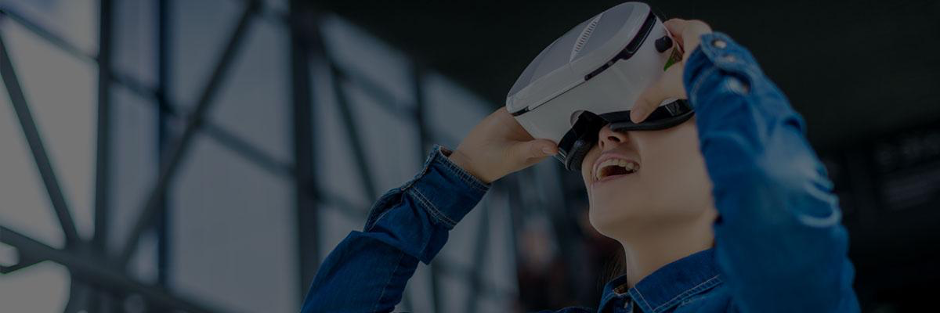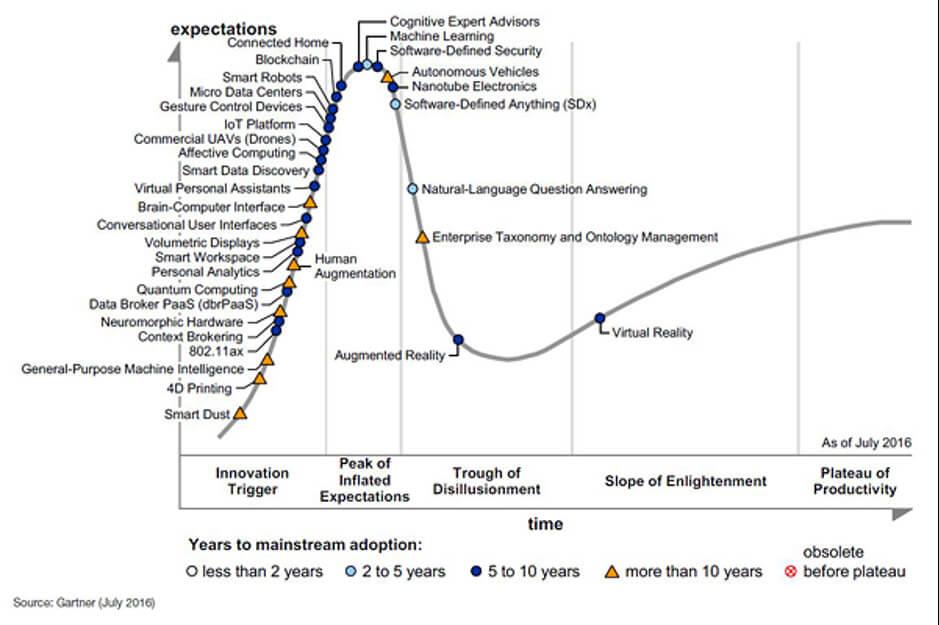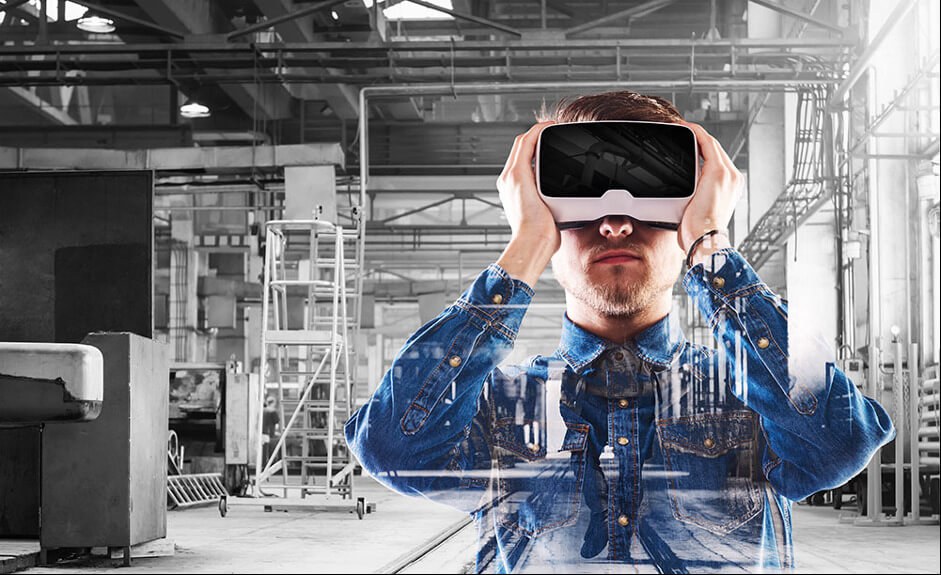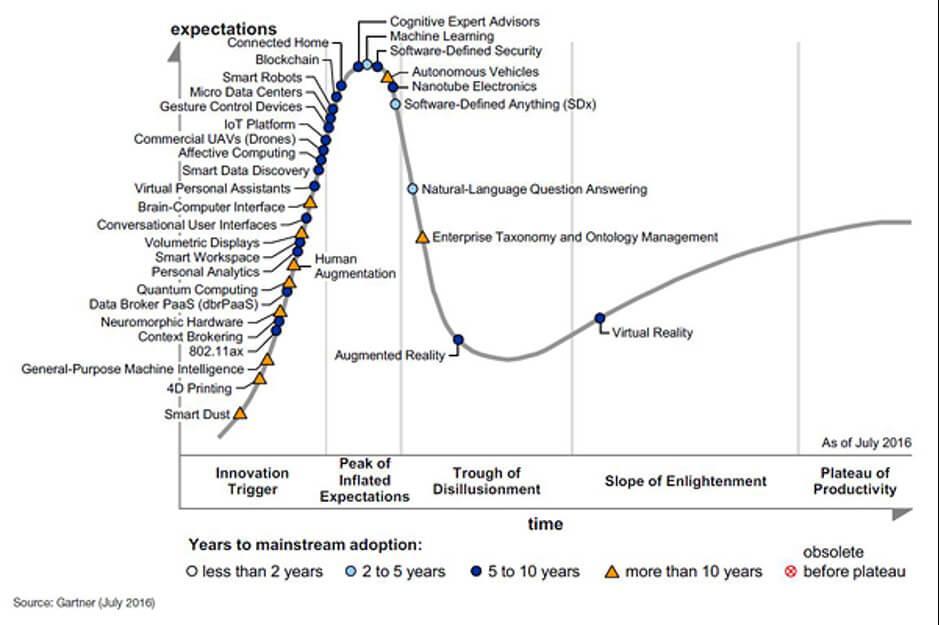Virtual, Augmented & Mixed Reality in digital learning

In this article our Lead 3D Artist, Alan Watson discusses the current hype around virtual reality (VR) and augmented reality (AR), and looks at how they can be used in digital learning to enhance the learner experience.
It would be nearly impossible to have missed the much-heralded “arrival” of virtual and augmented reality into our lives. Its promoters have promised to change the way we see and interact with the world around us, both real and digital. So, let’s take a look at how the two technologies are developing and see where they sit in the real world of digital learning solutions.
A brief look at this year’s Gartner Hype Cycle for Emerging Technologies shows that although VR is slowly beginning to climb the 'Slope of Enlightenment', AR is yet to reach the bottom of the beautifully named 'Trough of Disillusionment'.
The progression of VR can mostly be put down to the emergence and adoption of VR gaming and I’m sure that the recent 'Pokémon Go' phenomenon will move AR along the path somewhat in next year’s chart. However, it only gets exciting for us when it moves out of the entertainment sector and into practical usage within learning technologies.

Virtual Reality
VR is technology that uses computer-generated graphics, sounds and sensory feedback to attempt to replicate experiences and environments in either an actual or an imagined world.
In order to make the experience as immersive as possible, it is usually delivered via a head-mounted display, separating the user from any real-world distractions. Large-budget simulators will also do the same thing by immersing the user in a room surrounded by large screens in an attempt to get as close as possible to a 360° environment.

Augmented Reality
AR is generally a 'live' view of the real-world, which is overlaid and supplemented by additional computer-generated information. This additional information can be delivered in the form of 3d models, video and animation or web pages.
As Augmented Reality relies on the real-world, in order to experience it, the user is required to use a device equipped with a camera, such as a tablet, smart phone or a dedicated device like the short-lived Google Glass, or the upcoming Microsoft HoloLens.
The delivery of this augmented information is usually triggered by either geo-data (GPS positioning information) i.e. the user’s actual location, or by some form of visual trigger. Visual triggers can be QR codes, a pre-specified image or even the object itself.
Mixed Reality
When the two technologies of VR and AR converge, we have a hybrid which is referred to as 'Mixed Reality' (MR). This is a lesser-known term and can be thought of as a situation where a 3D model sits in virtual space but is viewed on top of a real object in its real-world space. When viewed through a device, the real and virtual worlds merge and co-exist in real-time.
So, what do these developments mean for the learning technologies sector?
Virtual Reality
We know that VR is already deployed large-budget simulators within the Oil & Gas Sector, the military, aeronautic and automotive industries.
The DART (Dynamic Advanced Response Training) drill Rig Simulator at Aberdeen’s RGU for example replicates a rig floor with a range of drilling equipment and control consoles. For most businesses that level of simulation is way beyond their required scope and financial restraints.
Within other professions the health and life-sciences seem particularly keen on the implementation of VR (and MR) in both training and in treatments (interestingly enough, this is where Google-Glass development has almost exclusively retired to).
In two very different approaches VR is being used to train surgeons without having to practice on real patients, and in terms of treatments it is currently being used for its analgesic effects when applied as a distractor during painful procedures. Interestingly from our perspective, there’s also a lot of work being done in the areas of phobias, where immersive environments can train the mind to react in a different way to a given set of circumstances (agoraphobia for example), enhancing the widely used “cognitive therapy” method of treatment.
Part of our business is about changing behaviours and if it can work in those medical fields then it’s not a big leap to see how it could work in ours, especially in the areas such as hazard awareness and crisis response and pre-mobilisation. Beyond that it could easily be used to teach mustering and evacuation procedures and, to a certain extent, emergency situations such as firefighting etc. It could also help to develop more effective evacuation routes, perhaps highlighting areas where people are prone to head down a dead end for example. VR could also be particularly effective with regards to inductions, plant familiarisation, equipment identification and any number of other applications.
There will inevitably be challenges to the general use of VR, a few that I can immediately foresee will be:
1. Cost - Building a credible, interactive, game-quality environment can be expensive and time-consuming, especially if logic and physics are required (for example, the user may be required to open a set of valves which would have consequences elsewhere in the operation). Expectations are high. We have been using high-quality, dedicated gaming consoles for a couple of decades now and the public expect game-quality visuals. A graphically sub-standard world is simply not going to cut it these days and will struggle to be taken seriously. The good news is that there are ways around this, utilising pre-existing assets which can be implemented quickly and cost-effectively, giving a high-quality, visually immersive experience without the costs of having to building a virtual world from scratch.
2. New Technology Adoption - Industries (especially Oil & Gas) can be slow to the point of stagnation when it comes to the adoption of innovative new techniques. There’s a lot of 'if it ain’t broke' thinking out there, and that caution is understandable, especially in the current climate. VR has actually been around for over twenty years and has yet to make the breakthrough, but maybe now is the time, technology has moved on immeasurably over that time and it will not be slowing down any time soon. Sometimes doing nothing is the sensible choice, but one of the biggest risks to take is refusing to take any risks at all. If we are completely risk-adverse, then we run the very real risk of becoming irrelevant and being left behind as new learning technologies inevitably appear. The secret to trying new ideas is to try them fast and try them cheap, that way if it doesn’t work out then you can fail fast and fail cheap, but at least you’ve tried, rather than sat back whilst others motored on.
3. Human behaviour - Will people actually take to standing around with a headset on, oblivious to those around them as they move and react to the set of circumstances being presented only to them? I don’t have the answer to that but I do have my doubts, in time that may change as headsets evolve and we may even get to a point where holograms are commonplace and the need for an individual headset is greatly diminished. But our own self-consciousness and preferred behaviours are something that must be considered. The makers of 3D televisions chose to ignore the way people actually use their sets and tried to force an unwanted technology on their consumers – technology for technology's sake - it cost them dearly.

Augmented Reality
Augmented Reality may well be wallowing in the “Trough of Disillusionment”, but I actually see a very bright future for the use of AR in learning technologies. The Learning and Knowledge sector should, in my opinion, be the major driving force behind the progression of Augmented Reality, rather than the current driver which appears to be sales and marketing. Being able to access or overlay information based on the things around us in the real world should be a game-changer in terms of the delivery of training. As an example, IKEA should not (as they currently do) have an AR app that shows people what their products look like in their living rooms, they should have an app showing how they are assembled. That’s a practical training use of real value.
Having the ability to access pertinent information, instruction and data where and when it’s required, overlaid on the world around us will allow us to see how to assemble and repair a complex piece of equipment, learn about a place or object, visualise internal workings and mechanics, navigate our environment, and enjoy a multitude of other uses, limited only by our imagination.
AR can also be used to take the learner out of the classroom environment, to explore their surroundings and locate areas of interest introducing a variation on the technique of “Spaced Learning”.
On a commercial level, it can drive people to our websites, lead them to relevant courses and allow them to purchase the appropriate material. Those who have previously purchased courses can retrieve information which they may have forgotten. This can be done without having to log-in, find the right chapter and click through the pages to retrieve the snippet of information being sought out. It can be delivered right there and then when required, because of the real-world link.
Imagine being on any industrial site, looking through your device and see the equipment in front of you tagged with its name, contents, inspection dates, maintenance schedule etc. Another tap on the phone and you’re watching a step-by-step video of the maintenance procedure which you’re about to undertake, if you’re under-qualified it may provide warnings not to proceed, look at your current qualifications passport and direct you to the correct learning path. Real, practical information accessed where and when it’s needed not only to help with the task at hand but to further progression and development.
I passionately believe that our world will quickly and inevitably become enhanced by Augmented Reality. It will ubiquitous, it will be irresistible, and it will be addictive.
Insights & News
At Mintra, we're so much more than just a team—we're a force driving innovation and excellence in maritime training across Europe.
We’re excited to be taking the stage at one of Europe’s leading showcases of organisational learning.
We are delighted to share the exciting news that our People and Culture team has been shortlisted for the prestigious cHeRries Awards!